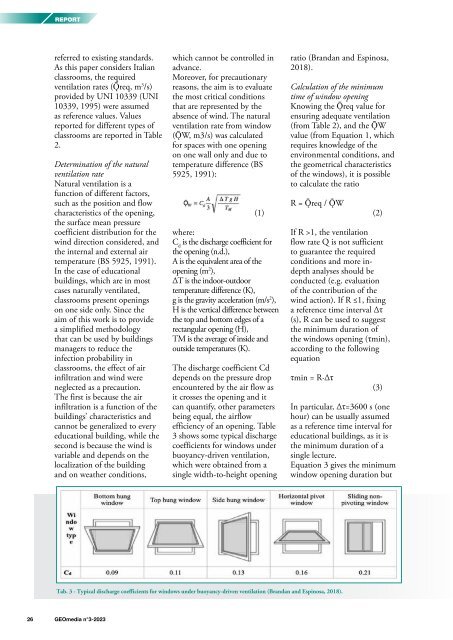GEOmedia_3_2023
EUMAP During the recent pandemic period, the world's attention has shifted towards the healthcare sector, with world leaders striving to avoid the collapse of their national healthcare systems; the economy has entered an artificial coma, while utility systems, including energy, water, telecommunications and waste management systems, have been asked to act immediately in response to these unprecedented conditions, placing extreme pressure on public utility systems.
EUMAP
During the recent pandemic period, the world's attention has shifted towards the healthcare sector, with world leaders striving to avoid the collapse of their national healthcare systems; the economy has entered an artificial coma, while utility systems, including energy, water, telecommunications and waste management systems, have been asked to act immediately in response to these unprecedented conditions, placing extreme pressure on public utility systems.
You also want an ePaper? Increase the reach of your titles
YUMPU automatically turns print PDFs into web optimized ePapers that Google loves.
REPORT<br />
referred to existing standards.<br />
As this paper considers Italian<br />
classrooms, the required<br />
ventilation rates (Ǭreq, m 3 /s)<br />
provided by UNI 10339 (UNI<br />
10339, 1995) were assumed<br />
as reference values. Values<br />
reported for different types of<br />
classrooms are reported in Table<br />
2.<br />
Determination of the natural<br />
ventilation rate<br />
Natural ventilation is a<br />
function of different factors,<br />
such as the position and flow<br />
characteristics of the opening,<br />
the surface mean pressure<br />
coefficient distribution for the<br />
wind direction considered, and<br />
the internal and external air<br />
temperature (BS 5925, 1991).<br />
In the case of educational<br />
buildings, which are in most<br />
cases naturally ventilated,<br />
classrooms present openings<br />
on one side only. Since the<br />
aim of this work is to provide<br />
a simplified methodology<br />
that can be used by buildings<br />
managers to reduce the<br />
infection probability in<br />
classrooms, the effect of air<br />
infiltration and wind were<br />
neglected as a precaution.<br />
The first is because the air<br />
infiltration is a function of the<br />
buildings’ characteristics and<br />
cannot be generalized to every<br />
educational building, while the<br />
second is because the wind is<br />
variable and depends on the<br />
localization of the building<br />
and on weather conditions,<br />
which cannot be controlled in<br />
advance.<br />
Moreover, for precautionary<br />
reasons, the aim is to evaluate<br />
the most critical conditions<br />
that are represented by the<br />
absence of wind. The natural<br />
ventilation rate from window<br />
(ǬW, m3/s) was calculated<br />
for spaces with one opening<br />
on one wall only and due to<br />
temperature difference (BS<br />
5925, 1991):<br />
(1)<br />
where:<br />
C d<br />
is the discharge coefficient for<br />
the opening (n.d.),<br />
A is the equivalent area of the<br />
opening (m 2 ),<br />
ΔT is the indoor-outdoor<br />
temperature difference (K),<br />
g is the gravity acceleration (m/s 2 ),<br />
H is the vertical difference between<br />
the top and bottom edges of a<br />
rectangular opening (H),<br />
TM is the average of inside and<br />
outside temperatures (K).<br />
The discharge coefficient Cd<br />
depends on the pressure drop<br />
encountered by the air flow as<br />
it crosses the opening and it<br />
can quantify, other parameters<br />
being equal, the airflow<br />
efficiency of an opening. Table<br />
3 shows some typical discharge<br />
coefficients for windows under<br />
buoyancy-driven ventilation,<br />
which were obtained from a<br />
single width-to-height opening<br />
ratio (Brandan and Espinosa,<br />
2018).<br />
Calculation of the minimum<br />
time of window opening<br />
Knowing the Ǭreq value for<br />
ensuring adequate ventilation<br />
(from Table 2), and the ǬW<br />
value (from Equation 1, which<br />
requires knowledge of the<br />
environmental conditions, and<br />
the geometrical characteristics<br />
of the windows), it is possible<br />
to calculate the ratio<br />
R = Ǭreq / ǬW<br />
(2)<br />
If R >1, the ventilation<br />
flow rate Q is not sufficient<br />
to guarantee the required<br />
conditions and more indepth<br />
analyses should be<br />
conducted (e.g. evaluation<br />
of the contribution of the<br />
wind action). If R ≤1, fixing<br />
a reference time interval ∆τ<br />
(s), R can be used to suggest<br />
the minimum duration of<br />
the windows opening (τmin),<br />
according to the following<br />
equation<br />
τmin = R∙∆τ<br />
(3)<br />
In particular, ∆τ=3600 s (one<br />
hour) can be usually assumed<br />
as a reference time interval for<br />
educational buildings, as it is<br />
the minimum duration of a<br />
single lecture.<br />
Equation 3 gives the minimum<br />
window opening duration but<br />
Tab. 3 - Typical discharge coefficients for windows under buoyancy-driven ventilation (Brandan and Espinosa, 2018).<br />
26 <strong>GEOmedia</strong> n°3-<strong>2023</strong>

















